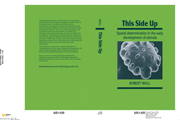Book contents
- Frontmatter
- Contents
- Preface
- Acknowledgements
- 1 Oogenesis
- 2 From oocyte to zygote
- 3 Does cleavage cut up a preformed spatial pattern?: the case of spiralian embryos
- 4 The limits of mosaicism in non-spiralian cleavage
- 5 Cellular interactions in the morula and blastula: the case of sea urchin embryos
- 6 Interactions at morula and blastula in other embryos
- 7 Interactions between moving cells: the case of amphibian gastrula
- 8 Spatial determination in the gastrulae of other groups
- 9 Determination in embryos showing partial cleavage
- 10 Patterns and mechanisms in early spatial determination
- References
- Index
- Frontmatter
- Contents
- Preface
- Acknowledgements
- 1 Oogenesis
- 2 From oocyte to zygote
- 3 Does cleavage cut up a preformed spatial pattern?: the case of spiralian embryos
- 4 The limits of mosaicism in non-spiralian cleavage
- 5 Cellular interactions in the morula and blastula: the case of sea urchin embryos
- 6 Interactions at morula and blastula in other embryos
- 7 Interactions between moving cells: the case of amphibian gastrula
- 8 Spatial determination in the gastrulae of other groups
- 9 Determination in embryos showing partial cleavage
- 10 Patterns and mechanisms in early spatial determination
- References
- Index
Summary
A study of the determination of spatial pattern in embryos clearly has to start long before fertilisation, in particular to find out how much pattern has been laid down during the development of the egg within the mother. This stage, oogenesis, has been extensively studied in recent years so that we now know quite a lot about the acquisition of organelles and molecules which will be used later in the embryo.
Brief background information about these processes will be given here. Evidence for patterned arrangements of materials within oocytes will be considered next. Finally, we will ask whether such patterns imply that the parts of the oocyte are already determined, i.e. have they specialised so that they are only capable of forming certain parts of the embryo?
The events of oogenesis
Oogenesis, of course, includes the division of the primordial germ cells to produce successive generations of oogonia, their eventual transformation to oocytes and the meiotic divisions of the oocytes. Most of the obvious preparation of the egg occurs in the prophase of the first meiotic division during which the primary oocyte grows, mainly by an increase in its stores of yolk, and there may be obvious signs of activity in the nucleus and elsewhere. The volumes of animal eggs are usually orders of magnitude greater than those of somatic cells, and the nucleus of the oocyte is also enlarged and commonly called the germinal vesicle.
- Type
- Chapter
- Information
- This Side UpSpatial Determination in the Early Development of Animals, pp. 1 - 30Publisher: Cambridge University PressPrint publication year: 1990



